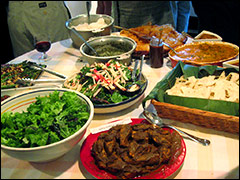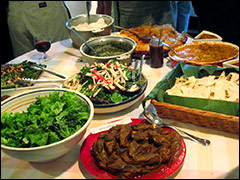This is the last in a series of articles about connecting with people over spring meals. Read others on setting up a dining co-op, celebrating Passover, hosting an Earth Dinner, and appreciating slow food.
In my last column, I wrote about the slow-food movement, which unites people interested in flavors, food preservation, and, of course, eating. The movement is international in its scope and impact, but it is active on the local level; there are currently 140 Slow Food chapters in the U.S. Known as convivia, these groups often feature speakers or tastings — or both. In Boston, for example, there was a sherry and tapas tasting last night, and there have been chocolate and cheese tastings in the past.
One of the things I like best about belonging to Slow Food is that you don’t have to be a “food professional” (e.g., chef, purveyor, or farmer) to join. Simply being interested in food is enough. Furthermore, and I know this may sound nerdy and starry-eyed, it’s exciting to be part of an international movement! It’s kind of cool knowing, every time I read Slow, the organization’s magazine, that it’s also being printed and read in Italian, French, German, Spanish, and Japanese. (The $60 Slow Food USA membership fee also gets you two newsletters, Snail and The Food Chain.)
When I was talking to Rosemary Melli, governor of the New England chapters of Slow Food USA, she told me that some members of the Boston convivium had decided they wanted to hold events that would be smaller, more intimate, and very affordable, while raising funds for the organization. Out of these needs, the slow-food potluck was born.
The potlucks are held in members’ homes, and everyone who attends puts $5 into the Slow Food pot. The response has been very positive, Melli says: members feel they have a chance to really talk and connect with one another. At a recent potluck in Boston, people shared strategies for how to eat locally during the winter, for example, and swapped favorite root-vegetable recipes.
Whether you host a sanctioned Slow Food potluck or pull together your own, it can be a great way to tap into your local food culture and to foster community — not to mention shirking cooking duties for a night. Here are some tips I’ve gleaned over many years of potlucks: the good, the bad, and the tasty.
Potluck Wisdom
First, some ideas for the host:
• You may want to keep a list of categories of food to keep track of what people are bringing. That way you won’t end up with 20 potato salads and no protein, unless that’s what you’re hoping for (actually, that gives me an idea for a theme party … Potatopalooza! Start peeling!). Be sure to find out if your guests will need to use your stove, microwave, or serving dishes.
• Provide lots of utensils, plates, cups, and napkins. There are some good recycled-paper plates made by Seventh Generation and others; you can also get reusable recycled-plastic utensils (put a sign on your garbage can so folks don’t toss them out). Buy serving utensils, bowls, and platters at yard sales and secondhand shops. Make sure you have containers for leftovers, too. I buy the disposable plastic ones and then — here’s the environmentally responsible part — I don’t throw them away!
• Provide index cards and markers so people can note the ingredients in their dishes. This is important if allergies are an issue, and can be a fun conversation starter.
• Put a garbage can right near the food table. Otherwise people can’t find the garbage and do things like leave paper plates covered with salad dressing and feta balanced precariously on the arm of your Ultrasuede sofa. (Not that I’m bitter.)
• While you’re stocking up at the yard sale, buy a game of Twister and some dress-up clothes if you are inviting kids. You may feel the urge to teach them the Macarena (if you remember it) and the Chicken Dance, and if you anticipate such activity, you will need to have the appropriate music handy. If people are bringing really small kids, you’ll want to provide a nap zone and a place designated for diaper changing and disposal. (This prevents people from changing diapers on your Ultrasuede couch. Not that I’m bitter.)
• Remember to enjoy yourself! If you are a control freak or uncomfortable with the idea of children with dripping popsicles running wild in your house, a potluck may not be for you. If you suspect that you are going to end up spending the whole time doing damage control, a sit-down dinner may be more your style, or you might want to hold your potluck in a park. Your most important duty as a host is to know thyself and act accordingly.
Now, a few tips for guests:
• Consider the venue: are people going to have a chance to sit down? If so, it’s fine to bring soup (as long as there are good solid mugs or decent bowls available, not flimsy paper bowls that don’t stand up to hot liquids) or anything that needs to be cut. Ever try to eat something that required cutting while standing with a paper plate in your hand? It’s enough to make one abandon one’s plate on the arm of an Ultrasuede sofa.
• Know your audience! If it’s a family-friendly potluck, you’ll want to serve some different foods than you might at, say, a Slow Food potluck. For example, don’t forget that sandwiches are a really wonderful contribution when there are kids or sloppy adults present. Sandwiches don’t generally spill, and you don’t even really need to use a plate or sit down to eat them. Viva the sandwich!
• Consider what kind of container you’ll use to serve and transport your dish before you commit to making it. It’s a shame to make a complex and delicious dish only to discover that you can’t really get it there in one piece.
• Bring a list of the ingredients you use. This is helpful in case anyone has allergies, religious dietary restrictions, or plain old secular dietary restrictions.
The Reubenesque Sandwich
Here’s a recipe for a “Reubenesque” sandwich — that is, a Reuben minus the corned beef, which makes it too heavy and fatty to enjoy. These are best to serve if you don’t have to drag them across town; the cheese will cool and congeal if it’s a long trip.
These sandwiches are simple, but delicious. To assemble each one you will need:
- 2 slices marble rye, dark rye, light rye, or pumpernickel bread
- 1 to 2 tablespoons sauerkraut from a jar (unless you make your own … more power to you!)
- 2 slices Jarlsberg cheese (it has a fantastic nutty flavor and contributes adhesive power that’s important to the structural integrity of the sandwich)
- 1 to 2 tablespoons Russian dressing (in other words, mayo and ketchup mixed together in a 1:1 ratio)
- lightly salted butter
Butter the outside of the bread and place, butter-side down, on a plate. On one slice of bread, layer a slice of Jarlsberg cheese, 1 to 2 tablespoons of sauerkraut that you have squeezed as dry as possible, 1 to 2 tablespoons of dressing, and another piece of cheese. Place the other slice of bread on top and heat the sandwich in a skillet over medium-high heat, cooking until the cheese is gooey. (If the bread is not getting a crusty enough texture for your taste, add a little more butter to the pan in 1-teaspoon increments, lifting the sandwich to let it slide underneath. This will make the sandwich extra delicious but also extra fat-laden.) Slice the sandwich in two and serve — with napkins, for the goo factor.




